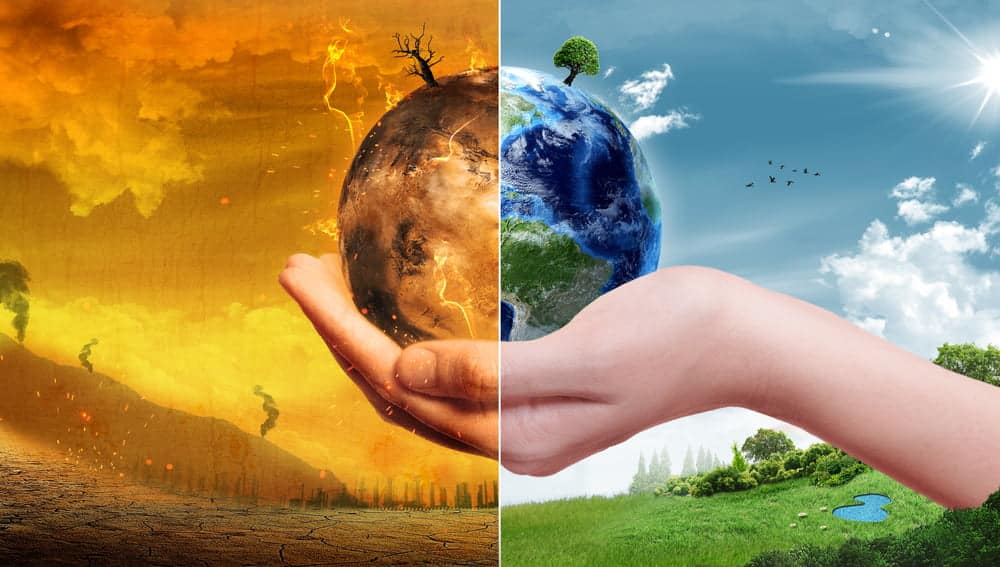Written by Grant Stringer, for the Oregon Capital Chronicle
The Earth is barreling toward “uncharted climate territory” and on track to become uninhabitable for three and six billion people by the end of the century, a new report found.
The research, led by Oregon State University scientists, casts dire warnings, saying big changes are needed now.
The State of the Climate report, by climate scientists from around the world summarized reams of evidence indicating that global efforts to curb greenhouse gas emissions are falling way short. The group, led by a professor and former researcher from Oregon State University, said only profound measures to protect people and the environment will give humanity “our best shot at surviving these challenges in the long run.”
The report does offer some hope that humanity can slash emissions fast enough to avert an all-out meltdown, though scientists said the Earth is already experiencing climate chaos and is approaching uncharted territory.
READ: Protecting Our Democracy Protects Our Environment
Twelve scientists published the report Tuesday in the peer reviewed journal BioScience, which is a publication of the American Institute of Biological Sciences. Oregon State professor William Ripple and former postdoctoral researcher Christopher Wolf are the lead authors.
“Life on planet Earth is under siege,” the report said. “For several decades, scientists have consistently warned of a future marked by extreme climatic conditions because of escalating global temperatures caused by ongoing human activities that release harmful greenhouse gases into the atmosphere. Unfortunately, time is up.”
The report summarized 45 studies and analyses to look at the state of Earth’s “vital signs,” such as global temperatures, forest cover and sea ice, amid the dovetailing climate and biodiversity crises. The authors found a planet in crisis that is dangerously close to several “tipping points” that could upend whole societies.
Possibilities of “worldwide societal breakdown are feasible and dangerously underexplored,” the scientists wrote.
The Earth broke “extraordinary” records in 2023, the report says. This summer was the warmest period ever recorded. In July, the Earth clocked the highest daily average surface temperature ever measured, which was possibly the planet’s hottest day in the last 100,000 years. Antarctic sea ice reached its lowest extent ever measured, while Canada suffered a wildfire season that released more than one billion tons of carbon – more than the country’s entire emissions in 2021, the report says.
Meanwhile, international climate action is woefully inadequate, according to the report. The authors concluded that the 2015 Paris Accords goal of limiting global temperature rise to 1.5 degrees Celsius will likely fail. That echoes the United Nations’ own assessment last year. Some scientists argue that the Earth essentially crossed that line this year.
The report called for a transformational effort across the globe to stave off “every further 0.1 (degree Celsius) increase in future global heating.”
The report comes a month before world leaders and experts are slated to meet in the United Arab Emirates for COP 28, the annual United Nations climate conference.
“We need both hope and action,” Ripple told the Capital Chronicle.
Increasing urgency
Ripple, a professor in Oregon State’s College of Forestry, and Wolf, who is now a scientist with Terrestrial Ecosystems Research Associates in Corvallis, have been sounding the alarm bells about the climate and biodiversity crises for years. In 2019, the pair declared a climate emergency with the Alliance of World Scientists. More than 15,000 scientists in 163 countries have signed on to date.
Scientists from Germany, China, Brazil, Bangladesh, Australia and other countries contributed to this year’s State of the Climate report.
The report notes some recent progress. Global use of renewable energy rose by 17% between 2021 and 2022, while the global rate of deforestation declined 10%. Deforestation will likely continue to slow in part due to new, climate-friendly protections for Brazil’s Amazon Rainforest, a critical carbon sponge, the report says. Last year, the United Nations created a new “loss and damage” fund for countries plagued by disasters in the southern hemisphere that are considered more vulnerable to climate change.
However, the scientists said that progress is “minimal.”
Emissions of carbon dioxide and other greenhouse gasses spiked in 2021 and 2022 after briefly declining during the worst of the COVID-19 pandemic. The concentration of carbon dioxide in the atmosphere is currently near 420 parts per million, far surpassing what scientists consider to be the safe boundary of 350 parts per million, which was passed in the 1980s. Coal consumption reached a near all-time high last year, and some Middle Eastern and Eastern European countries have poured record investment into fossil fuel subsidies in response to the Russia-Ukraine war, which disrupted the global supply of oil and gas.
READ: Montana Kids Win Historic Climate Lawsuit – Here’s Why It Could Set a Powerful Precedent
This year, scientists across the world described an unprecedented period of climate chaos. Along with record sea ice loss, the temperature of the world’s oceans rose to a record high, while the ocean’s acidity reached a record low.
A July study by Danish scientists suggested that the Atlantic Meridional Overturning Circulation, known as the Gulf Stream, could collapse sooner than expected this century. The current’s collapse would be a disastrous tipping point that could profoundly disrupt global weather patterns.
This year, severe floods inundated the U.S., China and Libya, including flooding in Kentucky and Missouri that caused more than $1 billion in damage. Wolf said in a statement that research suggests the intensity and frequency of climate-fueled disasters might be outpacing global temperature rise.
In the report, the scientists said they are “shocked by the ferocity of the extreme weather events in 2023.”
“We are afraid of the uncharted territory that we have now entered,” they wrote.
The report also notes that factors other than human-caused climate change may have contributed to 2023’s extreme weather and temperatures, such as the arrival of this year’s El Niño. A massive underwater volcanic eruption may have sent water vapor into the atmosphere, which is a greenhouse gas. Regulations limiting sulfur content in ocean shipping fuel may have also reduced aerosols in the atmosphere, which help counteract greenhouse gasses.
Ripple said that more research is necessary to suss out how much each factor shaped this extreme year, “but it’s clear that climate change due to greenhouse gas emissions is the main threat.”
“As global average temperatures continue to rise, the effects of short-term anomalies are likely to become increasingly severe, and may include more frequent extreme weather disasters,” he said in an email.
Call for transformation
The scientists wrote that the crisis requires an unprecedented effort across the globe.
“This is our moment to make a profound difference for all life on Earth, and we must embrace it with unwavering courage and determination to create a legacy of change that will stand the test of time,” they wrote.
In the report, they called for a fundamental shift in the global economy. The world must immediately move beyond fossil fuels, they wrote, while “decoupling” economic growth from extractive resources such as timber, minerals and ore. The report condemns a global economic system that supports “excessive consumption by the wealthy” — whose behaviors disproportionately harm the climate — while food insecurity and displacement rises among lower-income people.
Coal consumption in particular must cease immediately, particularly in China, which accounted for more than half of coal-related carbon emissions in 2021, the report said.
And more land-use policies are needed to sequester carbon, a key prong of the U.S. and international climate strategies, according to the report. This year, Oregon lawmakers established a $10 million fund for “natural climate solutions” that store carbon in forests, estuaries and other lands. The report calls for more research into carbon capture and storage technologies, but warned against relying upon them until they are proven and widely available.
READ: Fracking, Green Amendments, and Defending Democracy in Pennsylvania and Beyond
Ripple said efforts to address the biodiversity crisis and climate change at the same time, for example by protecting forests, may prove valuable. Old-growth forests in the Northwest promote biodiversity and support a slew of endangered species from salmon to the spotted owl. Older trees store much more carbon than younger trees.
“Big problems need big solutions,” the report says. “Therefore, we must shift our perspective on the climate emergency from being just an isolated environmental issue to a systemic, existential threat.”
Grant Stringer is a freelance journalist in Oregon who writes for national newspapers like the Washington Post and outlets in the West, including the Capital Chronicle and the Oregonian/OregonLive. He specializes in features, solutions journalism and social policy stories.
Oregon Capital Chronicle is part of States Newsroom, a network of news bureaus supported by grants and a coalition of donors as a 501c(3) public charity. Oregon Capital Chronicle maintains editorial independence. Contact Editor Lynne Terry for questions: info@oregoncapitalchronicle.com. Follow Oregon Capital Chronicle on Facebook and Twitter.






